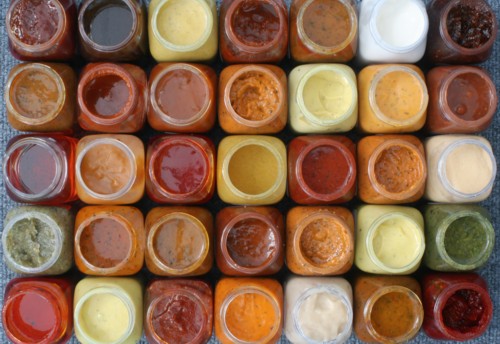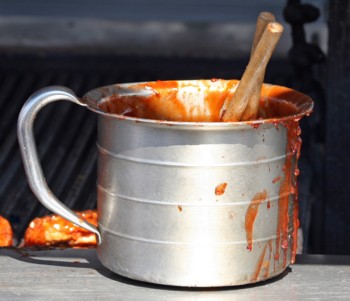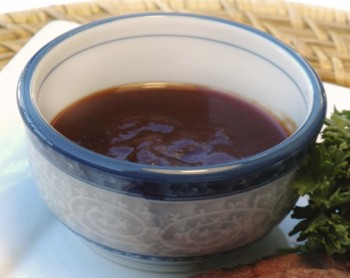Some barbecue purists argue true barbecue doesn’t need sauce because the smoked meat and the herb and spice rub that is added before cooking provide more than enough flavor. Others say it is the sauce that makes barbecue great. One thing is for sure: There are as many barbecue sauces as there are backyard grill masters and each cook has his or her favorite concoction developed to bring out the best in their barbecue’s taste, texture and flavor.
In his comprehensive book Championship Barbecue Sauces (Harvard Common Press, 1998),author Paul Kirk, Ph.B., the Kansas City Baron of Barbecue and a seven-time world grand champion, gives excellent advice: “A good sauce seasons and enhances,” he says. “It is not intended to hide or overpower or dominate! A sauce can give contrasting or complementary flavors. It can also add moisture, texture and visual interest to your barbecue.”

“There are generally considered to be four types of barbecue in the country and they, by and large, are broken down by the type of sauce used in basting and also as a finish sauce,” explains Lake E. High Jr., a South Carolinian and barbecue historian. “Those four, in order of historical emergence, are vinegar and pepper, mustard, light tomato and heavy tomato. And while there is always disagreement on the varieties of preparation, such as whether one should use a dry rub or a wet rub and various other culinary arguments, all of the many sauces used in America generally will fall into one of those four basic groups.”
A big pork rib and beef brisket town. Kansas City sauces are usually tomato-based with vinegar and are sweet, thick, spicy and commanding. Many believe Kansas City barbecue to be the best combination of all the regional styles.
Texas
Beef country! The sauce used is a tomato-based blend spiked with chili powder, paprika and cumin, limited only by what’s in the pantry.
Eastern North Carolina
Notable for whole hog cooked over oak or hickory wood then chopped and mixed with a vinegar-based sauce spiked with crushed red pepper flakes, black pepper, salt and sometimes granulated sugar.

Specializes in Boston butt (shoulder) pulled and bathed with a thin tomato-based sauce with a strong vinegar taste. Sometimes Worcestershire sauce and molasses are added to the sauce.
South Carolina
Historically regarded as the birthplace of barbecue in America, this is where Spanish settlers met with South Carolina Native Americans in the 1500s. Again, “pulled” pork is the meat but the sauce can be one of four different types including a mustard-based variety with vinegar and honey or molasses.
Memphis
Ribs and shredded pork dominate in Memphis. Memphis ribs come wet or dry–with or without sauce–but most come dry with a thick crust of dry rub. Western Tennessee shredded pork is mixed with a sweet tomato-based sauce, somewhat less spicy than a Texas-style sauce.
Kentucky
Sauces here include a mild tomato-based sauce, a peppery hot sauce, or a unique black sauce made of a basic vinegar sauce with molasses. During cooking, a combination of Worcestershire sauce, vinegar, lemon, salt, black pepper and water bastes the meat.
Alabama
Barbecue in Alabama is traditional Southern-style, but what makes Alabama stand out is its barbecue sauce. Unlike others that are tomato-based, northern Alabama features a white barbecue sauce, similar to a classic French Béchamel. Made with mayonnaise, vinegar, salt and pepper the sauce adds a delicate flavor to barbecued meats.
Open Pit was acquired by General Foods Corp. in 1960 and became part of Kraft Foods in 1989, when the two companies merged. Today, Open Pit is still owned by Kraft in the food service market, while the retail division was sold to Vlasic in 1987. In 2001, Vlasic was acquired by Pinnacle Foods. Open Pit was the leading sauce Today, Open Pit offers six flavors of its “original” style sauce and three flavors of the “Thick & Tangy” sauce that it introduced in 1986.
As a limited-time promotion in 1957, Kraft began attaching spice packets to its all-purpose oil, inspiring another nationally available commercial barbecue sauce. Thus, Kraft barbecue sauce was introduced in 1958 and reached national distribution in 1960. It wasn’t until 1984, however, that one of the most popular barbecue sauces was introduced: Kraft Thick ‘N’ Spicy Original Barbecue Sauce. Kraft Foods also produces the premium Bull’s-Eye barbecue sauce line, introduced in 1985 to regional markets and nationally in 1987.
Not to be left out of the growing market for barbecue sauces, the Pennsylvania-based H.L. Heinz Co. entered the fray. Heinz now produces the Jack Daniel’s lines of sauces.
K.C. Masterpiece sauce, developed in 1978 by former child psychiatrist Dr. Rich Davis of Kansas City, is another major national brand. When K.C. Masterpiece was sold to a division of Clorox Co. in 1985, sales were more than $4 million annually. The company today produces nine different flavors of barbecue sauces.
Hunt’s, a division of ConAgra Foods, produces “Hunt’s Original Barbecue Sauce,” another popular national brand.
Another player entered the retail market two years ago when French’s introduced its Cattlemen’s sauce to the retail market. Available to the food service industry for nearly 30 years and the number one selling food service barbecue sauce, Cattlemen’s has been used by the grand champions at the prestigious Memphis In May World Barbecue Championship for the past 14 years.
Recently, World Harbors, Inc. of Auburn, Maine, a division of Trinidad-based Angostura Limited, released their Buccaneer Blends line of five all-natural barbecue sauces. Sticky Rum, Apple Maple, Fra Diavlo, Honey Mango and Mesquite barbecue sauces join the company’s line of 16 gourmet sauces and marinades. Founded in 1990, the company was sold to in 2000.

Create Your Own “Signature” Sauce
Many barbecue teams and backyard cooks create their own barbecue sauces, either from scratch or using a commercial product as a base. The components of any tomato-based sauce usually include tomato (paste, sauce, ketchup or chili sauce), aromatic vegetables (garlic, shallots, bell peppers or onions), a sweet taste (molasses, sugar, brown sugar, honey, corn syrup or maple syrup) and a sour flavor (vinegar, lemon juice, lime juice, wine or Worcestershire sauce) while vinegar-based sauces usually just contain vinegar, salt, pepper, crushed red pepper flakes and other spices.
“Keep good notes on what you did,” recommends Culinary Institute of America graduate Richard McPeake of Kansas City. “Test your final product and determine what you like or maybe don’t like. When going back to retest, only change one ingredient at a time.” Chef McPeake is the author of “Backyard BBQ,: The Art of Smokology” and a member of the Rib Stars barbecue team.
Here are a couple of recipes I developed for two classic barbecue sauces along with my take on Alabama White Sauce. You can use them as a starting point to create your own signature sauces.
Basic Barbecue Sauce

1 medium yellow onion, chopped (about 1 cup)
4 cloves garlic, minced
2 jalapeño chiles, seeded and finely diced
2 tablespoons hot Hungarian paprika
2 cups ketchup
1 (12-ounce can beer
1 whole tomato, seeded and diced
1/3 cup fresh lemon juice
1/4 cup dark molasses
1/4 cup Worcestershire sauce
1/4 cup dark brown sugar
1 1/2 tablespoons Old Bay seasoning
1 teaspoon coarse kosher salt
1/2 teaspoon cracked black pepper
Melt the butter in a large saucepan over medium heat. Add the onion, garlic and jalapeños. Cook, stirring occasionally, until the onions wilt. Add the paprika and cook briefly. Add the remaining ingredients and stir well to incorporate. Bring to a boil, reduce heat and simmer partially covered for one hour.
Heat Scale: Mild
South Carolina Mustard Sauce
Thanks to the German immigrants that populated South Carolina in the 18th century, mustard became a popular condiment and the base for this unique barbecue sauce. One of the more popular commercial mustard-based sauces is Maurice’s Carolina Gold BBQ Sauce. This is my version on the traditional South Carolina sauce.
1/4 cup tomato paste
1/4 cup dark brown sugar
1/4 cup apple cider vinegar
1 tablespoon Worcestershire sauce
1/2 teaspoon freshly ground black pepper
1/2 teaspoon ground cayenne pepper
1/2 teaspoon granulated garlic
In a medium saucepan over medium heat combine all of the ingredients. Stir and simmer for five minutes to dissolve the sugar.
Heat Scale: Mild
1/3 cup apple cider vinegar
1 1/2 tablespoons granulated sugar
1 tablespoon fresh lemon juice
1 tablespoon freshly ground black pepper
2 teaspoons prepared horseradish
1/2 teaspoon coarse kosher salt
1/2 teaspoon ground cayenne
Combine all of the ingredients in a medium mixing bowl and whisk well to combine.
Heat Scale: Mild
Remus Powers Ph.B., known in real life as Ardie Davis of Kansas City, is one of the premier barbecue experts in the country and the author of several barbecue books including The Great Barbecue Sauce Book (Ten Speed Press, 1999). This is his recipe for a classic Kansas City style sauce.
1/2 teaspoon curry powder
1/2 teaspoon chili powder
1/2 teaspoon paprika
1/4 teaspoon allspice
1/4 teaspoon cinnamon
1/4 teaspoon mace
1/4 cup white vinegar
1 cup ketchup
1/3 cup dark molasses
1/2 teaspoon hot pepper sauce
Place all of the dry ingredients into a bowl. Add the vinegar and stir. Add remaining ingredients and stir until mixture is thoroughly blended. This sauce may be served at room temperature or heated.
Yield: About 1 1/2 cups
Heat Scale: Mild
Presidential Barbecue Sauce
Although President Lyndon B. Johnson, a Texas native, was known to host barbecues for visiting dignitaries at both the White House and his Texas ranch, he was not the first president to enjoy barbecue. The Eisenhower Center in Abilene, Kansas, the presidential library of Texas-born President Dwight D. Eisenhower, has this recipe archived from the 34th president’s personal collection.
2 cups drained whole tomatoes
1 small yellow onion, finely chopped
1/4 cup vinegar
1 tablespoon sugar
1 tablespoon paprika
2 teaspoons salt
2 teaspoons chili powder
1 1/2 teaspoons Worcestershire sauce
1 teaspoon black pepper
1/4 teaspoon Tabasco sauce or more to taste
Combine all of the ingredients in a medium saucepan. Bring to a simmer over medium heat and cook, stirring occasionally, for about 15 minutes. Use for basting meat or chicken and serve as a table sauce.
Heat Scale: Mild
Dave Klose’s Texas Sauce
Dave Klose of Houston has been a world-renowned manufacturer of custom barbecue smokers since 1986 (www.bbqpits.com). Here’s his recipe for a Texas-style barbecue sauce.
2 cups ketchup
1 cup cider vinegar
1 cup minced yellow onion
1 cup Worcestershire sauce
Juice of 4 lemons (about 1/2 cup)
1 stick butter (1/2 cup)
1/4 cup brown sugar
3 tablespoons honey
4 cloves garlic, pressed (about 4 teaspoons) 2 teaspoons salt
1 teaspoon black pepper
1 teaspoon garlic salt
1 teaspoon ground cayenne
1 dash Tabasco sauce
Combine the ingredients in a medium saucepan over medium heat. Bring to a simmer and cook, stirring occasionally, for 12 minutes.
Heat Scale: Mild to medium
Lake High’s Vinegar and Pepper BBQ Basting Sauce
1/2 cup kosher or sea salt (not the kind in the round blue box)
1/3 cup red pepper flakes
1/4 cup freshly ground black pepper
1 tablespoon sugar or 1/2 cup of molasses (to give it good “mouth feel” and take the edge off the vinegar)
Combine all of the ingredients in a large mixing bowl and whisk to incorporate.
Heat scale: Mild to medium




